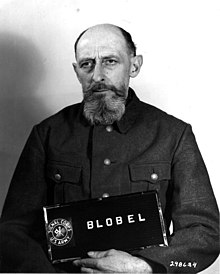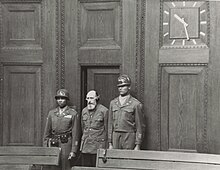Paul Blobel
Paul Blobel | |
|---|---|
Execution by hanging | |
| Known for | |
| Criminal status | Einsatzgruppen Trial |
| Criminal penalty | Death |
| Details | |
| Victims | 60,000+ |
Span of crimes | June 1941 – 1944 |
| Country | Poland, Ukraine, and Yugoslavia |
SS-Standartenführer | |
| Unit | Einsatzgruppe C |
| Commands held | Sonderkommando 4a Sonderaktion 1005 |
Paul Blobel (13 August 1894 – 7 June 1951) was a German
Early life
Born in the city of

SS career

In 1933 Blobel joined the police force in
On 10 or 11 August 1941,
The Wehrmacht had already dug a grave. The children were brought along in a tractor. The Ukrainians were standing around trembling. The children were taken down from the tractor. They were lined up along the top of the grave and shot so that they fell into it. The Ukrainians did not aim at any particular part of the body. ... The wailing was indescribable.[4]: 217
Blobel, in conjunction with Reichenau's and
: 234Blobel was officially relieved of his command on 13 January 1942 for health reasons due to
In October 1944 he headed an
Hartl had told me of a summer evening—that same hot summer in 1942—in Kyiv when he was invited to dine with the local Higher SS Police Chief and Brigadeführer, Max Thomas. A fellow guest, SS Colonel Paul Blobel, had driven him to the general's weekend dacha. "At one moment—it was just getting dark," said Hartl, "we were driving past a long ravine. I noticed strange movements of the earth. Clumps of earth rose into the air as if by their own propulsion—and there was smoke; it was like a low-toned volcano; as if there was burning lava just beneath the earth. Blobel laughed, made a gesture with his arm pointing back along the road and ahead, all along the ravine—the ravine of Babi Yar—and said, 'Here lie my thirty-thousand Jews.'"[7]
Trial and conviction

Over 59,018 killings are attributable to Blobel, albeit he personally claimed to have killed 10,000–15,000 people. He was later sentenced to death by the U.S.

Blobel's last words were "Whatever I have done, I did as a soldier who obeyed orders. I have committed no crime. I will be vindicated by God and history. God have mercy on those who murder me."[9][10]
In the media
- Blobel was portrayed by actor T. P. McKenna in the 1978 miniseries Holocaust.
- Blobel is an historical character in Herman Wouk's book War and Remembrance. He was portrayed by actor Kenneth Colley in the television adaptation of the book.
References
- ISBN 0-02-897502-2.
- ISBN 978-2-286-03062-9
- ^ Ogorreck, Ralf, op. cit. p. 203.
- ^ ISBN 978-0-06-019043-9.
- OCLC 52838928
- ^ 1941: Mass Murder The Holocaust Chronicle. p. 270
- ^
ISBN 978-0-7126-7447-8. Sereny also mentions the story in her 1995 biography of Albert Speer: Sereny, Gitta (1996). Albert Speer: His Battle With Truth (1996 paperback ed.). London: Picador. p. 272.ISBN 978-0-330-34697-9.
- ^ "Five death sentences were confirmed: the sentence against Oswald Pohl, as well as those passed against the leaders of the Mobile Killing Units, Paul Blobel, Werner Braune, Erich Neumann and Otto Ohrlendorf. ... In the early morning hours of 7 June, the [] Nazi criminals were hanged in the Landesburg prison courtyard." Norbert Frei, Adenauer's Germany and the Nazi Past: The Politics of Amnesty and Integration. Columbia University Press, 2002. p. 165 and p. 173
- ^ "Seven Nazis Were Hanged: The Diary of a Witness". Commentary Magazine. 1 May 1960. Retrieved 29 July 2022.
- ISSN 0040-781X. Retrieved 29 September 2022.
